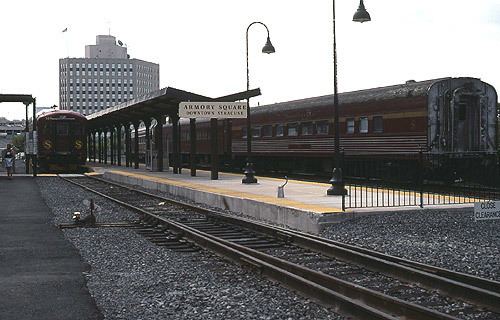Number of lines 1 Began operation 1994 | Transit type Commuter rail Daily ridership 75 (2005) | |
 | ||
Number of stations 3 (full time)2 (flag stops)3 (seasonal)3 (proposed but never opened) | ||
OnTrack was a regional rail line that operated in Syracuse, New York from 1994 to 2007. During much of its operation, Syracuse was the smallest city in the United States to have regional train service. The line ran from Colvin Street on the city's south side via Syracuse University and Armory Square to the Carousel Center, using four Budd Rail Diesel Cars (RDC-1) built in the 1950s. It was operated by the New York, Susquehanna and Western Railway.
Contents
History
When service began in 1994, the trains ran between Syracuse University, Armory Square and Carousel Center ten times a day, seven days a week. In 2005, service was limited to Saturdays. The fare was $1.50. OnTrack also ran the "Orange Express" shuttle during Syracuse University Carrier Dome events. This shuttle was more successful.
OnTrack was the subject of criticism for failing to re-paint its railroad bridges over Erie Boulevard and South Geddes, West Fayette and West Genesee Streets. Congressman Jim Walsh appropriated $3 million in 2002 for OnTrack, although the company insisted the money was earmarked for structural rather than cosmetic improvements.
Financing was approved in April 2004 to build a bridge that would allow OnTrack to reach the William F. Walsh Regional Transportation Center, Central New York Regional Market, and NBT Bank Stadium. These stations had been built and most of the track had been laid, with simply the bridge link missing.
OnTrack was heavily subsidized with roughly $8 million of state money spent on the system. In order to be profitable, OnTrack needed 500 riders a day; at its height it received 75. In July 2007, OnTrack ended service indefinitely.
Ambitious unrealized plans for the future of OnTrack included:
Stations
From north to south:
Stations planned for an expanded Salvation Army facility downtown were cancelled when the Syracuse Salvation Army received word in January 2006 that it had not been selected as one of the recipients of a grant from the Kroc Foundation, run by Joan B. Kroc. The foundation had donated $1.6 billion to be used for 48 new community centers nationwide. The grant proposal had requested $36 million for a facility offering recreation, arts, education and work force development.
Only Alliance Bank Stadium, Carousel Center, Armory Square and Syracuse University stops had platforms. All were outdoor with a small covered area.
Fleet
All OnTrack cars were owned by New York, Susquehanna and Western Railway and returned to NYSWR upon the demise of the commuter rail service. By 2008, the RDCs were either sold or out of service.
